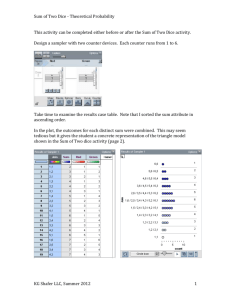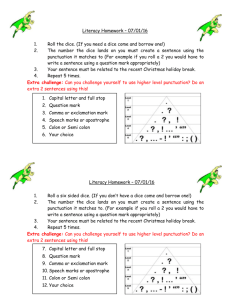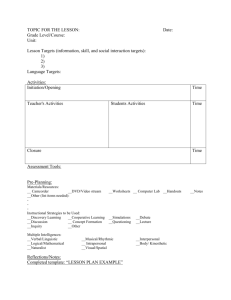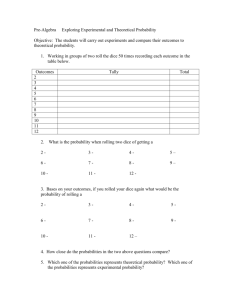CONSTRUCTING TASK: Building Base-Ten Numbers
advertisement
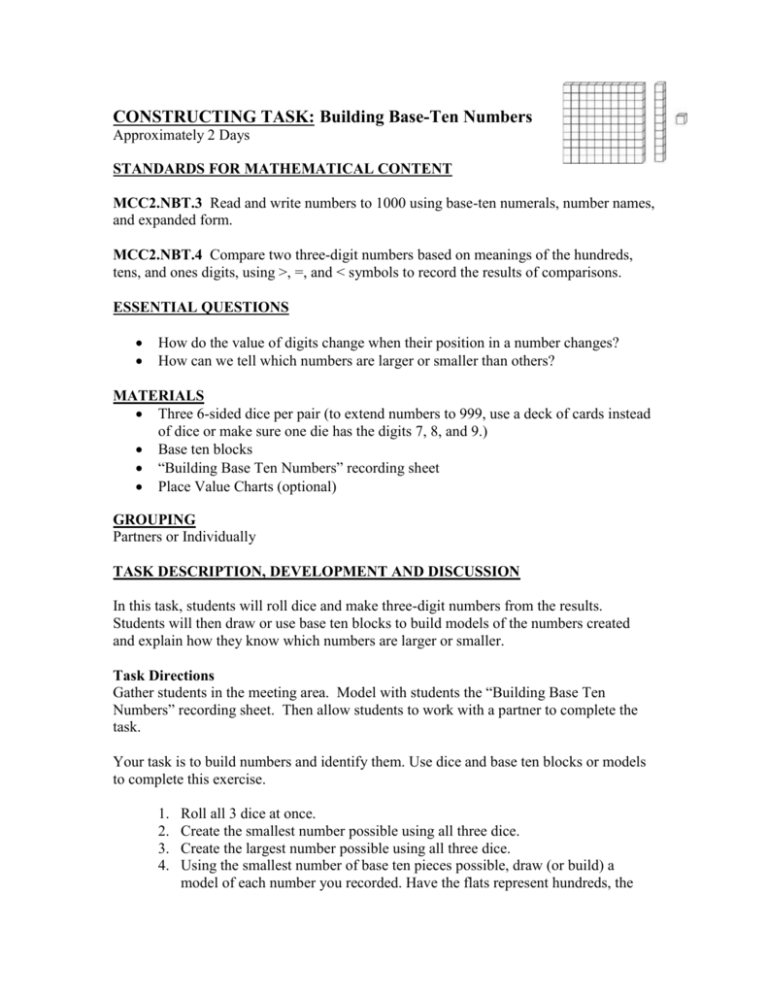
CONSTRUCTING TASK: Building Base-Ten Numbers Approximately 2 Days STANDARDS FOR MATHEMATICAL CONTENT MCC2.NBT.3 Read and write numbers to 1000 using base-ten numerals, number names, and expanded form. MCC2.NBT.4 Compare two three-digit numbers based on meanings of the hundreds, tens, and ones digits, using >, =, and < symbols to record the results of comparisons. ESSENTIAL QUESTIONS How do the value of digits change when their position in a number changes? How can we tell which numbers are larger or smaller than others? MATERIALS Three 6-sided dice per pair (to extend numbers to 999, use a deck of cards instead of dice or make sure one die has the digits 7, 8, and 9.) Base ten blocks “Building Base Ten Numbers” recording sheet Place Value Charts (optional) GROUPING Partners or Individually TASK DESCRIPTION, DEVELOPMENT AND DISCUSSION In this task, students will roll dice and make three-digit numbers from the results. Students will then draw or use base ten blocks to build models of the numbers created and explain how they know which numbers are larger or smaller. Task Directions Gather students in the meeting area. Model with students the “Building Base Ten Numbers” recording sheet. Then allow students to work with a partner to complete the task. Your task is to build numbers and identify them. Use dice and base ten blocks or models to complete this exercise. 1. 2. 3. 4. Roll all 3 dice at once. Create the smallest number possible using all three dice. Create the largest number possible using all three dice. Using the smallest number of base ten pieces possible, draw (or build) a model of each number you recorded. Have the flats represent hundreds, the rods represent tens, and the unit cubes represent ones. Use words to write how each of the two numbers is spoken. Write the numbers in expanded notation. 5. Repeat the same exercise two more times and record. 6. When you have completed all your rolls, put a star beside the greatest number you rolled. Then put a check beside the smallest number you rolled. Explain how you know what the largest and smallest numbers are possible when using three dice. FORMATIVE ASSESSMENT QUESTIONS How did you decide in which order to place your dice? What would happen if you changed the order of your dice? What would happen to the size of your numbers if you used more or fewer dice? Which representation of your numbers makes the most sense to you? DIFFERENTIATION Extension Students may use four dice instead of three (or use three dice and always have one digit be zero). If you continue to have them draw/build base ten models, you will need to provide the large cube in the base ten blocks to represent the thousands place. If students have access to base ten stamps, those may be used instead of, or in addition to, the actual manipulatives. Intervention Students may need to use a place value chart to align their digits. Have students complete the task in small groups with direct instruction or modeling for additional support. For students who have difficulty counting the dots on a die, dice with numbers printed on them may be used. Name: ________________________________ Building Base-Ten Numbers Your task is to build numbers and identify them. Use dice and base ten blocks or models to complete this exercise. 1. Roll all 3 dice at once. 2. Create the smallest number possible using all three dice. 3. Create the largest number possible using all three dice. 4. Using the smallest number of base ten pieces possible, draw (or build) a model of each number you recorded. Have the flats represent hundreds, the rods represent tens, and the unit cubes represent ones. Use words to write how each of the two numbers is spoken. Write the numbers in expanded notation. 5. Repeat the same exercise two more times and record. 6. When you have completed all your rolls, put a star beside the greatest number you rolled. Then put a check beside the smallest number you rolled. Explain how you know what the largest and smallest numbers are possible when using three dice. Roll #1 Smallest Number Model with Drawings Largest Number Model with Drawings Expanded Notation (ex. 200 + 30 + 5) Expanded Notation Roll #2 Smallest Number Model with Drawings Largest Number Model with Drawings Expanded Notation Expanded Notation Roll #3 Smallest Number Model with Drawings Largest Number Model with Drawings Expanded Notation Expanded Notation




